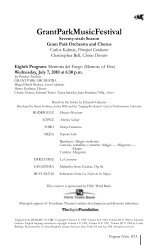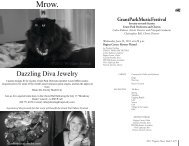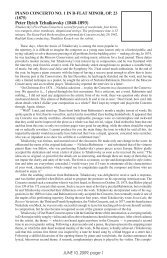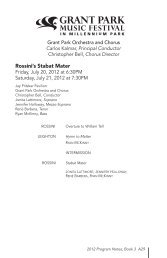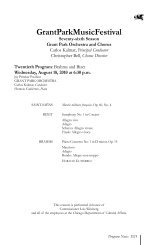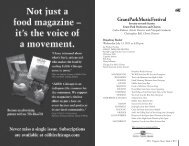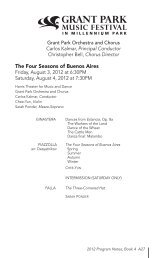Program Notes PDF - The Grant Park Music Festival
Program Notes PDF - The Grant Park Music Festival
Program Notes PDF - The Grant Park Music Festival
Create successful ePaper yourself
Turn your PDF publications into a flip-book with our unique Google optimized e-Paper software.
<strong>Grant</strong> <strong>Park</strong> Orchestra and Chorus<br />
Carlos Kalmar, Principal Conductor<br />
Christopher Bell, Chorus Director<br />
Opening Night<br />
Wednesday, June 12, 2013 at 6:30PM<br />
Jay Pritzker Pavilion<br />
<strong>Grant</strong> <strong>Park</strong> orchestra<br />
Carlos Kalmar, Conductor<br />
Stefan Jackiw, Violin<br />
NORMAN<br />
MOZART<br />
Drip Blip Sparkle Spin Glint Glide Glow<br />
Float Flop Chop Pop Shatter Splash<br />
Violin Concerto No. 5 in A Major, K. 219, “Turkish”<br />
Allegro aperto<br />
Adagio<br />
Tempo di Menuetto — Allegro —<br />
Tempo di Menuetto<br />
Stefan Jackiw<br />
INTERMISSION<br />
TCHAIKOVSKY Symphony No. 4 in F Minor, Op. 36<br />
Andante sostenuto — Moderato con anima<br />
Andantino in modo di canzona<br />
Scherzo: Pizzicato ostinato (Allegro)<br />
Finale: Allegro con fuoco<br />
2013 <strong>Program</strong> <strong>Notes</strong>, Book 1 A5
carlos kalmar’s biography can be found on page 8.<br />
Wednesday, June 12, 2013<br />
American violinist STEFAN JACKIW is fast earning a reputation<br />
on both sides of the Atlantic. Of Korean/German heritage, Jackiw<br />
began studying the violin at the age of four; his teachers have<br />
included Zinaida Gilels, Michèle Auclair and Donald Weilerstein.<br />
In 2002 he was awarded the prestigious Avery Fisher Career<br />
<strong>Grant</strong>. At age fourteen, Jackiw made a sensational debut with<br />
the Philharmonia Orchestra at the Royal <strong>Festival</strong> Hall performing<br />
the Mendelssohn Concerto and “took the London music world<br />
by storm” (<strong>The</strong> Strad). In 2002 Jackiw made his debut with the<br />
Baltimore Symphony and has become a regular guest with that orchestra and toured<br />
with them to Japan. Elsewhere in North America, he has performed with the orchestras<br />
of New York, Philadelphia, Cleveland, Boston, Seattle, San Francisco, Pittsburgh,<br />
Cincinnati, Toronto and Chicago. He also appeared with the YouTube Symphony<br />
in Sydney at the invitation of Michael Tilson-Thomas. In recital, Stefan Jackiw has<br />
performed at the Schleswig-Holstein <strong>Music</strong> <strong>Festival</strong>, Louvre, Aspen, Ravinia, Kennedy<br />
Center, Mostly Mozart, Metropolitan Museum of Art and Carnegie Hall’s Zankel Hall.<br />
He gave the world premiere of a new work for violin and piano by American composer<br />
David Fulmer in Carnegie Hall in November 2012. Recent highlights include concerts<br />
with RTVE Madrid, BBC Scottish Symphony, Detroit Symphony, Tapiola Sinfonietta,<br />
Residentie Orkest, Singapore Symphony, Malaysian Philharmonic, Adelaide, West<br />
Australian and Melbourne Symphony Orchestras, Netherlands Philharmonic and a Far<br />
East tour with the Royal Philharmonic.<br />
A6 2013 <strong>Program</strong> <strong>Notes</strong>, Book 1
Wednesday, June 12, 2013<br />
Drip Blip Sparkle Spin Glint Glide Glow<br />
Float Flop Chop Pop Shatter Splash (2005)<br />
Andrew Norman (born in 1979)<br />
Drip ... is scored for three flutes, two oboes, three clarinets, two<br />
bassoons, four horns, three trumpets, three trombones, tuba,<br />
timpani, percussion, piano and strings. <strong>The</strong> performance time is<br />
five minutes. This is the first performance of Drip ... by the <strong>Grant</strong><br />
<strong>Park</strong> Orchestra.<br />
In announcing Andrew Norman as one of the four emerging composers receiving<br />
commissions through “Project 440,” a musical celebration of its fortieth anniversary<br />
season, the Orpheus Chamber Orchestra described him as “a lifelong enthusiast for<br />
all things architectural who writes music that is often inspired by forms and ideas he<br />
encounters in the visual world. His music draws on an eclectic mix of sounds and usually<br />
features some combination of bright colors, propulsive energy, a healthy dose of lyricism,<br />
and the fragmentation of musical ideas into little pieces.”<br />
Norman was born in Grand Rapids, Michigan, in 1979 and raised in central California.<br />
He earned his undergraduate degree at the University of Southern California Thornton<br />
School of <strong>Music</strong>, where he studied composition with Donald Crockett and Stephen Hartke<br />
and piano with Stewart Gordon, and an Artist Diploma from the Yale School of <strong>Music</strong>, where<br />
he was a student of Pulitzer Prize-winning composer Aaron Jay Kernis. Norman’s orchestral<br />
and chamber works have been commissioned and premiered by the Minnesota Orchestra,<br />
Zurich Tonhalle Orchestra, Los Angeles Philharmonic, Aspen <strong>Music</strong> <strong>Festival</strong>; he is currently<br />
serving a three-year residency with the Los Angeles Chamber Orchestra. Norman’s rapidly<br />
accumulating distinctions include fellowships from the American Academies in both Rome<br />
and Berlin, Nissim Prize and five Morton Gould Young Composer Awards from American<br />
Society of Composers, Authors and Publishers Charles Ives Scholarship from the American<br />
Academy of Arts and Letters, and a BMI Student Composer Award. His string trio <strong>The</strong><br />
Companion Guide to Rome was named a finalist for the 2012 Pulitzer Prize in <strong>Music</strong>.<br />
Drip was commissioned by the Minnesota Orchestra in 2005 for their Young People’s<br />
Concerts. Norman writes, “<strong>The</strong> process of writing it was a bit like making a tossed salad. I<br />
chopped up sounds from the orchestra — one sound for each of the thirteen verbs in the<br />
title — and then I tossed them all together and called it a piece.”<br />
Violin Concerto No. 5 in A major, K. 219,<br />
“Turkish” (1775)<br />
Wolfgang Amadeus Mozart (1756-1791)<br />
Mozart’s A major Violin Concerto is scored for two oboes, two<br />
horns and strings. <strong>The</strong> performance time is 31 minutes. <strong>The</strong><br />
<strong>Grant</strong> <strong>Park</strong> Orchestra first performed this work on July 25, 1956,<br />
with Izler Solomon conducting; Eudice Shapiro was the soloist.<br />
Mozart’s five authentic Violin Concertos were all products of<br />
a single year — 1775. At nineteen he was already a veteran of five years experience<br />
as concertmaster of the archiepiscopal court in Salzburg, for which his duties included<br />
not only playing, but also composing, acting as co-conductor with the keyboard player<br />
(modern orchestral conducting was not to originate for at least two more decades), and<br />
soloing in concertos. It was for this last function that Mozart wrote these concertos. He<br />
2013 <strong>Program</strong> <strong>Notes</strong>, Book 1 A7
Wednesday, June 12, 2013<br />
was, of course, a quick study at everything that he did, and each of these works builds<br />
on the knowledge gained from its predecessors. It was with the last three (K. 216, 218,<br />
219) that something more than simple experience emerged, however, because it was<br />
with these compositions that Mozart indisputably entered the era of his musical maturity.<br />
<strong>The</strong>se are his earliest pieces now regularly heard in the concert hall, and the last one,<br />
No. 5 in A major, is the greatest of the set.<br />
<strong>The</strong> opening movement is in sonata-concerto form, but has some curious structural<br />
experiments more associated with the music of Haydn than with that of Mozart. After the<br />
initial presentation of the thematic material by the orchestra, the soloist is introduced<br />
with the surprising device of a brief, stately Adagio. When the Allegro tempo resumes,<br />
the soloist plays not the main theme already announced by the ensemble, but a new<br />
lyrical melody for which the original main theme becomes the accompaniment. More<br />
new material fills the remainder of the exposition. <strong>The</strong> development section is invested<br />
with passages of dark harmonic color which cast expressive shadows across the generally<br />
sunny landscape of the movement, and lend it emotional weight. <strong>The</strong> recapitulation calls<br />
for restrained, elegant virtuosity from the soloist. <strong>The</strong> second movement is a graceful<br />
song in sonatina form (sonata-allegro without development). <strong>The</strong> final movement is an<br />
extended rondo in the style and rhythm of a minuet.<br />
Symphony No. 4 in F minor, Op. 36 (1877-1878)<br />
Peter Ilyich Tchaikovsky (1840-1893)<br />
Tchaikovsky’s Fourth Symphony is scored for pairs of woodwinds<br />
plus piccolo, four horns, two trumpets, three trombones, tuba,<br />
timpani, percussion and strings. Performance time is 44 minutes.<br />
<strong>The</strong> <strong>Grant</strong> <strong>Park</strong> Orchestra first performed this Symphony on<br />
September 8, 1935, with Frederick Stock conducting.<br />
<strong>The</strong> Fourth Symphony was a product of the most turbulent<br />
time of Tchaikovsky’s life — 1877, when he met two women who forced him to evaluate<br />
himself as he never had before. <strong>The</strong> first was the music-loving widow of a wealthy<br />
Russian railroad baron, Nadezhda von Meck, who became the financial backer who<br />
allowed him to quit his irksome teaching job at the Moscow Conservatory. Though<br />
they never met, her place in Tchaikovsky’s life was enormous and beneficial.<br />
<strong>The</strong> second woman to enter Tchaikovsky’s life in 1877 was Antonina Miliukov, a<br />
student in one of his large lecture classes at the Conservatory who had worked herself<br />
into a passion over her professor. Tchaikovsky paid her no special attention, and he had<br />
quite forgotten her when he received an ardent love letter professing her flaming and<br />
unquenchable desire to meet him. Tchaikovsky (age 37), who should have burned the<br />
thing, answered the letter of the 28-year-old Antonina in a polite, cool fashion, but did<br />
not include an outright rejection of her advances. He had been considering marriage<br />
for almost a year in the hope that it would give him both the stable home life that<br />
he had not enjoyed in the twenty years since his mother died and help dispel rumors<br />
of his homosexuality. He believed he might achieve both these goals with Antonina.<br />
What a welter of emotions must have gripped his heart when, just a few weeks later, he<br />
proposed marriage to her! Inevitably, the marriage crumbled within days of the wedding<br />
amid Tchaikovsky’s searing self-deprecation.<br />
It was during May and June that Tchaikovsky sketched the Fourth Symphony,<br />
A8 2013 <strong>Program</strong> <strong>Notes</strong>, Book 1
Wednesday, June 12, 2013<br />
finishing the first three movements before Antonina began her advances; the finale was<br />
completed by the time he proposed. Because of this chronology, the program of the<br />
Symphony was not a direct result of his marital disaster. All that — the July wedding,<br />
the mere eighteen days of bitter conjugal farce, the two separations — postdated<br />
the composition of the Symphony by a few months. What Tchaikovsky found in his<br />
relationship with this woman (who died in a mental ward in 1917, still legally married to<br />
him) was a confirmation of his belief in the inexorable workings of Fate in human destiny.<br />
Tchaikovsky wrote, “<strong>The</strong> introduction [blaring brasses heard immediately in a motto<br />
theme that recurs throughout the Symphony] is the kernel of the whole Symphony.<br />
This is Fate, which hinders one in the pursuit of happiness. <strong>The</strong>re is nothing to do but<br />
to submit and vainly complain [the melancholy, syncopated shadow-waltz of the main<br />
theme, heard in the strings]. Would it not be better to turn away from reality and lull one’s<br />
self in dreams? [<strong>The</strong> second theme is begun by the clarinet.] But no — these are but<br />
dreams: roughly we are awakened by Fate. [A brass fanfare begins the development.]<br />
<strong>The</strong> second movement shows another phase of sadness. How sad it is that so much has<br />
already been and gone! It is sad, yet sweet, to lose one’s self in the past. In the third<br />
movement are capricious arabesques, vague figures which slip into the imagination<br />
when one is slightly intoxicated. Military music is heard in the distance. As to the finale,<br />
if you find no pleasure in yourself, go to the people. <strong>The</strong> picture of a folk holiday. [<strong>The</strong><br />
finale employs the folk song A Birch Stood in the Meadow.] Rejoice in the happiness of<br />
others — and you can still live.”<br />
©2013 Dr. Richard E. Rodda<br />
Spend Your Time<br />
Building Your Business,<br />
Not Searching For<br />
Office Space<br />
I’ll save you time and money on<br />
your next offi ce lease<br />
• Tenant Representation, from consultation<br />
through lease negotiations<br />
Commercial Real Estate Consultants Serving Chicago Since 1981<br />
222 S. Morgan St., Suite 3A Darryl Brehm<br />
Chicago, IL 60607 (312) 229-6671<br />
dbrehm@anovitz.com<br />
2013 <strong>Program</strong> <strong>Notes</strong>, Book 1 A9



